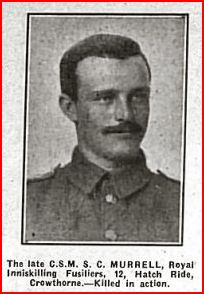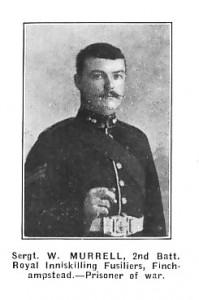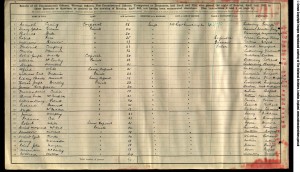 Sidney Murrell Died 20th November 1917
Sidney Murrell Died 20th November 1917
Sidney was born in 1889 in Finchampstead, Berkshire to father James and mother Sarah (nee Payne). He was the fifth born and had nine siblings, three brothers and six sisters. By the age of 19, Sidney had already signed up to the Fusilliers.
He joined the Royal Inniskilling Fusiliers 7/8th Battalion, was a Lance Corporal at the age of 19 and a Sergeant at the time of his death on the 20th November 1917. He also left a wife Emily, but we do not know of any children.
Wikipedia provides us with an account of the colossal actions Sidney would have been been involved in during the whole of the war:
‘The Division began forming as part of the K2 Army Group
towards the end of 1914 after Irish recruits in the early days of the war from England and Belfast first filled the ranks of the 10th (Irish) Division before being assigned to the 16th Division,[2] formed around a core of National Volunteers.[2] Initial training began in Ireland at Fermoy,[3] Munster; recruits also trained at Buttevant. It moved to Aldershot in England for more intensive training in September 1915. After thirteen weeks, the formation was deployed to Etaples in France, joining the BEF, from where it left on December 18 for that part of the front in the Loos salient, under the command of Irish Major General William Hickie. It spent the rest of the war on the Western Front.
At Loos, in January and February 1916, the division was introduced to trench warfare and suffered greatly in the Battle of Hulluch, 27–29 April, (during the Easter Rising in Ireland). Personnel raided German trenches all through May and June, and in late July they were moved to the Somme Valley where they were intensively engaged in the Battle of the Somme.
 The 16th division played an important part in capturing the towns of Guillemont and Ginchy, although they suffered massive casualties. During these successful actions between 1 and 10 September casualties amounted to 224 officers and 4,090 men; despite these very heavy losses the division gained a reputation as first-class shock troops.[4] Out of a total of 10,845 men, it had lost 3,491 on the Loos sector between January and the end of May 1916, including heavy casualties from bombardment and a gas attack at Hullach in April. Bloodletting of this order was fatal to the division’s character, for it had to be made good by drafts from England.[5]
The 16th division played an important part in capturing the towns of Guillemont and Ginchy, although they suffered massive casualties. During these successful actions between 1 and 10 September casualties amounted to 224 officers and 4,090 men; despite these very heavy losses the division gained a reputation as first-class shock troops.[4] Out of a total of 10,845 men, it had lost 3,491 on the Loos sector between January and the end of May 1916, including heavy casualties from bombardment and a gas attack at Hullach in April. Bloodletting of this order was fatal to the division’s character, for it had to be made good by drafts from England.[5]
In early 1917, the division took a major part in the Battle of Messines alongside the 36th (Ulster) Division, adding to both their recognition and reputation. Their major actions ended in the summer of 1917 at the Battle of Passchendaele after coming under the command of General Hubert Gough and the Fifth Army. In July 1917, during the Third Battle of Ypres, although both divisions were totally exhausted after 13 days of moving weighty equipment under heavy shelling, Gough ordered the battalions to advance through deep mud towards well fortified German positions left untouched by totally inadequate artillery preparation. By mid August, the 16th had suffered over 4,200 casualties, the 36th almost 3,600, or more than 50% of their numbers. General Haig was very critical of Gough for “playing the Irish card”’.
Sidney is also remembered on the Finchampstead Memorial
 Name: MURRELL Initials: S C
Name: MURRELL Initials: S C
Nationality: United Kingdom
Rank: Serjeant Regiment/Service: Royal Inniskilling Fusiliers Unit Text: 7th/8th Bn.
Age: 29
Date of Death: 20/11/1917
Service No: 9632
Additional information: Son of James and Sarah Murrell, of Finchampstead, Berks; husband of Emily Murrell, of Church View, Hurst, Twyford, Berks.
Grave/Memorial Reference: II. A. 8. Cemetery: CROISILLES BRITISH CEMETERY. The 7th Division attacked Croisilles in March 1917 and took it on 2 April. It was lost on 21 March 1918 and recaptured by the 56th (London) Division on the following 28 August, after heavy fighting. Plots I and II of the cemetery, were made between April 1917 and March 1918 and the rest was formed after the Armistice, when graves were brought in from the neighbouring battlefields and from some smaller burial grounds. The majority of the soldiers buried in the cemetery belonged to the Guards, 7th and 21st Divisions. Croisilles British Cemetery now contains 1,171 Commonwealth burials and commemorations of the First World War.
Church View, Hurst, Twyford, Berkshire.


